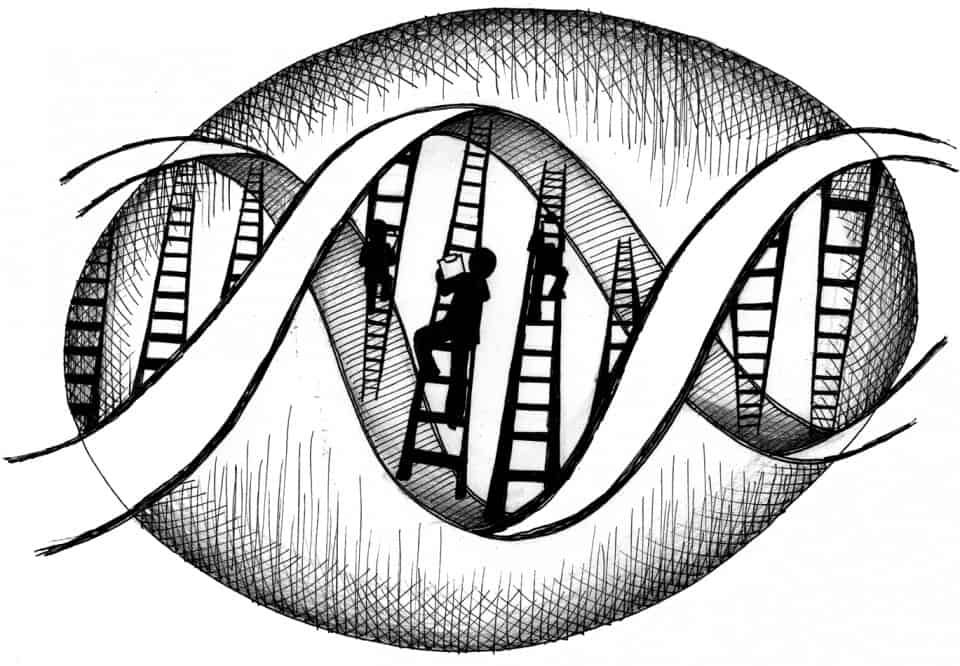Genomics is the study of the chemical letters that represent the genetic code of a species. Often, discoveries in genomics are discussed in terms of their medical potential. Although the potential medical benefits are great, there are also many other areas of biology that use genomic data. One such field is, perhaps surprisingly, the study of cooperation.
Understanding cooperation is one of the greatest challenges facing evolutionary biologists. The reason is that Darwin’s theory of natural selection tells us that selfish behaviour is often the best strategy. Normally when we think of cooperation, we think of individuals joining together to form groups. This approach, however, misses one important feature of the living world: its hierarchical organization. In the centre of the hierarchy is the individual. Then, above the individual in the hierarchy are groups; lions hunt together in packs and emperor penguins form compact huddles to stay warm during the cold Antarctic winters. At the next level up in the hierarchy we find groups of different species coming together in mutually beneficial relationships. For example, many plants act as a food and shelter resource for ants in return for protection against herbivores. Moving down the hierarchy, below the level of the individual, cells come together to form individual organisms, genomes come together to form cells, and genes form chromosomes that form genomes. At each level of the biological hierarchy, cooperation must thrive over competition.
A common metaphor for living organisms, like bacteria, plants, or animals, is that they are like machines. Under this metaphorical framework, it is assumed that a single organism functions as one integrated whole. Genes, then, are blueprints to build different components of the machinery. An alternative perspective, however, is to consider genes as members belonging to social groups, such as groups of chromosomes and genomes. From this point of view, it follows that, just like at other levels of the hierarchy, cooperation cannot just be taken for granted. It is there and it must be explained.
Cooperation among genes usually works very well. The absolute majority of body functions require the coordinated effort of more than one gene. For example, at any given moment, almost 18,000 genes are involved in keeping the human liver going. So, why would genes not always cooperate? One reason is that not all genes are inherited in the same way. Take, for example, transposable elements. These are discrete DNA sequences with the ability to replicate and transpose (move) from one part of the genome to another, which has earned them the nickname ‘jumping genes.’ They do not obey the Mendelian rules that usually govern how genes are inherited.
The movement of transposable elements often causes severe problems. For example, in Drosophila (the fruit fly that geneticists love to play with), this movement is the greatest source of mutations. In humans, transposable elements have been linked to Haemophilia and predisposition to cancer. Despite this, transposable elements are tremendously common. They constitute 45 per cent of all DNA in humans, and in some crops, like maize and barley, the figure is above 80 per cent. The prevalence of transposable elements is a clear example of when cooperation in the genome has broken down in favour of selfish behaviour.
Attempts to understand when cooperation is favoured in the genome have so far had a strong theoretical bent. However, now that more and more species have their whole genomes sequenced, it begins to be possible to attack this question with additional strength: testing mathematical models with actual data. One way to do it is to compare the genomes of closely related species. For example, why does the plant species Arabidopsis thaliana have a genome with 23 per cent transposable elements, whereas its close relative Arabidopsis lyrata has almost 30 per cent?
One hint could come from the fact that the two species differ in how they mate. So called outcrossing plants, like Arabidopsis lyrata, mate just like we do. A sex cell from one individual is transported to another, where it fuses with another sex cell (we have sperms and eggs while plants have pollen and ovules). Self-fertilizing Arabidopsis thaliana, however, mates with itself. In other words, a given individual produces both the male and female sex cells and the fusion occurs in the same individual.
To understand why mating systems should matter, put yourself in the shoes of a transposable element. Now, in a self-fertilizing species, you are in the same genome group every generation, whereas in an outcrossing species, you end up in a new group every time. The idea is that the interests of the transposable element and the rest of the genome are more closely aligned in self-fertilizing species. As a consequence, the prediction is that transposable elements will evolve to be more aggressive in outcrossing than in self-pollinating species. In other words, transposable elements can spread like a sexually transmitted disease. Thus, outcrossing species are expected to have more transposable elements than self-fertilizing species.
This is just one of many predictions that is currently being tested. Whereas cooperation has previously been studied at the levels of individuals and groups, the genomics revolution has opened a gold mine of data, allowing the social interactions at life’s lowest levels to be fully understood for the first time.


